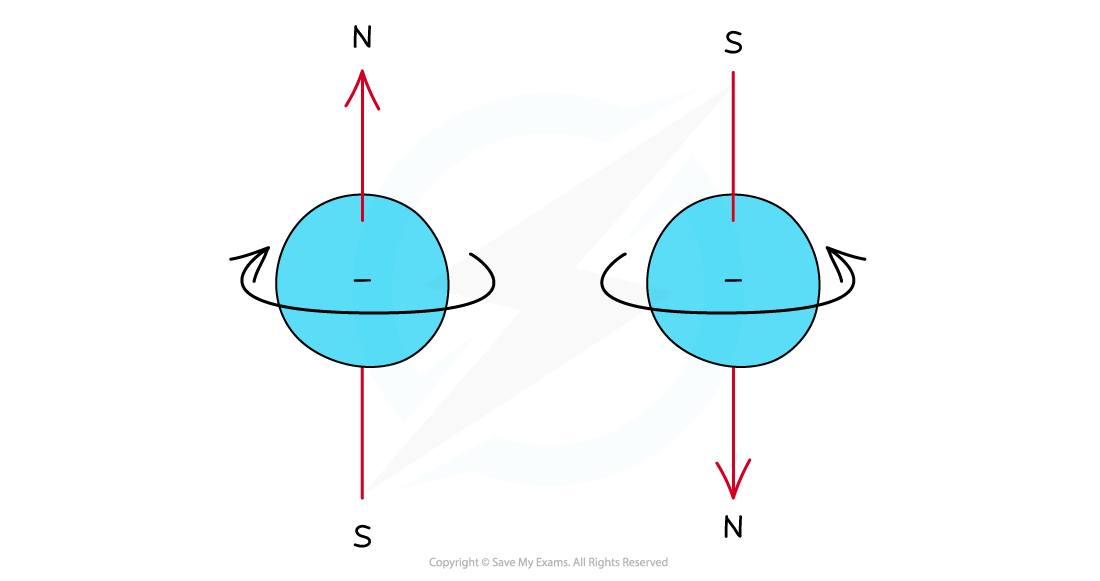Electron Configurations: Basics
- The electron configuration gives information about the number of electrons in each shell, subshell and orbital of an atom
- The subshells are filled in order of increasing energy

The electron configuration shows the number of electrons occupying a subshell in a specific shell
Electron Configurations: Explained
- Electrons can be imagined as small spinning charges which rotate around their own axis in either a clockwise or anticlockwise direction
- The spin of the electron is represented by its direction
- The spin creates a tiny magnetic field with N-S pole pointing up or down

Electrons can spin either in a clockwise or anticlockwise direction around their own axis
- Electrons with the same spin repel each other which is also called spin-pair repulsion
- Therefore, electrons will occupy separate orbitals in the same subshell first to minimise this repulsion and have their spin in the same direction
- They will then pair up, with a second electron being added to the first p orbital, with its spin in the opposite direction
- This is known as Hund's Rule
- E.g. if there are three electrons in a p subshell, one electron will go into each px, py and pz orbital

Electron configuration: three electrons in a p subshell
- The principal quantum number indicates the energy level of a particular shell but also indicates the energy of the electrons in that shell
- A 2p electron is in the second shell and therefore has an energy corresponding to n = 2
- Even though there is repulsion between negatively charged electrons, they occupy the same region of space in orbitals
- An orbital can only hold two electrons and they must have opposite spin - the is known as the Pauli Exclusion Principle
- This is because the energy required to jump to a higher empty orbital is greater than the inter-electron repulsion
- For this reason, they pair up and occupy the lower energy levels first
Orbital Diagrams
- The electron configuration can also be represented using the orbital spin diagrams
- Each box represents an atomic orbital
- The boxes are arranged in order of increasing energy from lower to higher (i.e. starting from closest to the nucleus)
- The electrons are represented by opposite arrows to show the spin of the electrons
- E.g. the box notation for titanium is shown below

The electrons in titanium are arranged in their orbitals as shown. Electrons occupy the lowest energy levels first before filling those with higher energy
Determining Electronic Configurations
- Writing out the electronic configuration tells us how the electrons in an atom or ion are arranged in their shells, subshells and orbitals
- This can be done using the full electron configuration or the shorthand version
- The full electron configuration describes the arrangement of all electrons from the 1s subshell up
- The shorthand electron configuration includes using the symbol of the nearest preceding noble gas to account for however many electrons are in that noble gas, followed by the rest of the electron configuration
- Ions are formed when atoms lose or gain electrons
- Negative ions are formed by adding electrons to the outer subshell
- Positive ions are formed by removing electrons from the outer subshell
- The transition metals fill the 4s subshell before the 3d subshell, but they also lose electrons from the 4s first rather than from the 3d subshell
- The Periodic Table is split up into four main blocks depending on their electronic configuration:
- s block elements (valence electron(s) in s orbital)
- p block elements (valence electron(s) in p orbital)
- d block elements (valence electron(s) in d orbital)
- f block elements (valence electron(s) in f orbital)

The elements can be divided into four blocks according to their outer shell electron configuration
Exceptions to the Aufbau Principle
- Chromium and copper have the following electron configurations:
- Cr is [Ar] 3d5 4s1 not [Ar] 3d4 4s2
- Cu is [Ar] 3d10 4s1 not [Ar] 3d9 4s2
- This is because the [Ar] 3d5 4s1 and [Ar] 3d10 4s1 configurations are energetically favourable
- By promoting an electron from 4s to 3d, these atoms achieve a half full or full d-subshell, respectively
Worked Example
Write down the full and shorthand electron configuration of the following elements:
- Potassium
- Calcium
- Gallium
- Ca2+
Answer:
Answer 1:
- Potassium has 19 electrons so the full electronic configuration is:
1s2 2s2 2p6 3s2 3p6 4s1
- The 4s orbital is lower in energy than the 3d subshell and is therefore filled first
- The nearest preceding noble gas to potassium is argon which accounts for 18 electrons so the shorthand electron configuration is:
[Ar] 4s1
Answer 2:
- Calcium has 20 electrons so the full electronic configuration is:
1s2 2s2 2p6 3s2 3p6 4s2
- The 4s orbital is lower in energy than the 3d subshell and is therefore filled first
- The shorthand version is [Ar] 4s2 since argon is the nearest preceding noble gas to calcium which accounts for 18 electrons
Answer 3:
- Gallium has 31 electrons so the full electronic configuration is:
[Ar] 3d10 4s2 4p1
Answer 4:
- If you ionise calcium and remove two of its outer electrons, the electronic configuration of the Ca2+ ion is identical to that of argon:
Ca2+ is 1s2 2s2 2p6 3s2 3p6
Ar is also 1s2 2s2 2p6 3s2 3p6
Exam Tip
Orbital spin diagrams can be drawn horizontally or vertically, going up or down the page - there is no hard and fast rule about this. The important thing is that you label the boxes and have the right number of electrons shown. The arrows you use for electrons can be full or half-headed arrows, but they must be in opposite directions in the same box.
